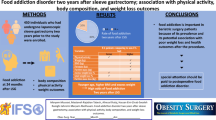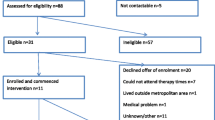Abstract
Objective
To observe the effects of acupoint thread-embedding therapy and low-carbohydrate diet therapy on obese patients with food addiction.
Methods
Sixty-five eligible patients were randomized into a thread-embedding group of 33 cases and a diet group of 32 cases to respectively receive 12-week treatment. Before treatment, after treatment and at 6-month follow-up, the two groups were observed and compared in terms of body mass (BM), waist circumference (WC), hip circumference (HC), waist-to-hip ratio (WHR), body mass index (BMI), body fat rate (BFR), basal metabolic rate (BMR) and Yale food addiction scale version 2.0 (YFAS 2.0).
Results
At the end of treatment, there were no significant differences in the general efficacy, and the improvements in BM, BMI, WC, HC, WHR and BFR between the thread-embedding group and diet group (all P>0.05). At follow-up, the thread-embedding group showed more significant improvements in all the aforementioned indicators compared with the diet group except HC (all P<0.05). At the end of treatment and follow-up, BMR and YFSA 2.0 had more significant improvements in the thread-embedding group than in the diet group (all P<0.05).
Conclusion
Acupoint thread-embedding therapy can produce significant efficacy in treating obese patients with food addiction; it can improve the food addiction state and work better in maintaining the efficacy compared with low-carbohydrate diet therapy.
【摘要】
目的: 观察穴位埋线疗法及低碳水饮食疗法对食物成瘾性肥胖患者的影响. 方法: 将符合纳入标准的65例患者随机分为埋线组33例及饮食组32例, 分别治疗12周. 于治疗前, 疗程结束时, 随访6个月时比较两组患者体质量(BM), 腰围(WC), 臀围(HC), 腰臀比(WHR), 身体质量指数(BMI), 体脂率(BFR), 基础代谢率(BMR)以及耶鲁食物成瘾量表2.0(YFAS2.0)评分的变化。结果: 疗程结束时, 埋线组与饮食组在总体疗效, BM, BMI, WC, HC, WHR和BFR改善方面的差异无统计学意义(均P>0.05); 随访时埋线组除HC外, 以上其他指标的改善情况均优于饮食组(均P<0.05); 疗程结束时和随访时, 埋线组BMR和YFSA2.0评分均较饮食组改善明显(均P<0.05). 结论: 穴位埋线疗法对食物成瘾性肥胖患者疗效明显, 并能改善患者食物成瘾状态, 维持疗效的作用优于低碳水饮食疗法.
Similar content being viewed by others
References
Lassale C, Tzoulaki I, Moons KGM, Sweeting M, Boer J, Johnson L, Huerta JM, Agnoli C, Freisling H, Weiderpass E, Wennberg P, van der A DL, Arriola L, Benetou V, Boeing H, Bonnet F, Colorado-Yohar SM, Engström G, Eriksen AK, Ferrari P, Grioni S, Johansson M, Kaaks R, Katsoulis M, Katzke V, Key TJ, Matullo G, Melander O, Molina-Portillo E, Moreno-Iribas C, Norberg M, Overvad K, Panico S, Quirós JR, Saieva C, Skeie G, Steffen A, Stepien M, Tjønneland A, Trichopoulou A, Tumino R, van der Schouw YT, Verschuren WMM, Langenberg C, Di Angelantonio E, Riboli E, Wareham NJ, Danesh J, Butterworth AS. Separate and combined associations of obesity and metabolic health with coronary heart disease: a pan-European case-cohort analysis. Eur Heart J, 2018, 39(5): 397–406.
Yang L, Colditz GA. Prevalence of overweight and obesity in the United States, 2007–2012. JAMA Intern Med, 2015, 175(8): 1412–1413.
He YN, Zhao WH, Zhao LY, Yu DM, Zhang J, Yang XG, Ding GQ. Prevalence of metabolic syndrome in Chinese adults in 2010–2012. Zhonghua Liuxingbingxue Zazhi, 2017, 38(2): 212–215.
Finlayson G. Food addiction and obesity: unnecessary medicalization of hedonic overeating. Nat Rev Endocrinol, 2017, 13(8): 493–498.
Rogers PJ. Obesity-is food addiction to blame?. Addiction, 2011, 106(7):1213–1214.
Dagher A. Is obesity caused by food addiction?. Canadian J Diabetes, 2013, 37(Suppl 2): S235–S236.
Zheng MJ, Guo ZB, Zheng BD, Zeng SX. Progress in research on food addiction and its implications. Shipin Kexue, 2015, 36(9): 271–278.
Dong YH, Sun LM, Li L. New definition of obesity and novel evaluation and discussion of obesity diagnosis in the Asia-Pacific Region. Liaoning Shiyong Tangniaobing Zazhi, 2001, 9(2): 3–6.
Ministry of Health of the People’s Republic of China. Guiding Principles for Clinical Study of New Chinese Medicines. Beijing: China Medical Science Press, 2002: 233–235.
Schulte EM, Gearhardt AN. Development of the modified Yale food addiction scale version 2.0. Eur Eat Disord Rev, 2017, 25(4): 302–308.
Yu K, Liu YP. Medical nutritional therapy for obesity. Zhongguo Yixue Kexueyuan Xuebao, 2011, 33(3): 239–242.
Wei BH, Jia BP. Diagnosis and efficacy evaluation criteria for simple obesity. Zhongguo Zhongxiyi Jiehe Zazhi, 1998, 18(5): 317–319.
Zhou LY, He TF, Chu XY, Song YH, Bing XH, Ding JL, Duan XD, Luo YB, Shi Y, Tao SP. Warm needling moxibustion versus electroacupuncture for simple obesity due to yang deficiency of the spleen and kidney: a controlled clinical trial. J Acupunct Tuina Sci, 2019, 17(4): 258–263.
Yu C, Shen B, Xu YP. Correlation between phlegm dampness constitution and simple obesity. Zhongguo Yiyao Zhinan, 2017, 15(11): 201–202.
Sutherland MT, Stein EA. Functional neurocircuits and neuroimaging biomarkers of tobacco use disorder. Trends Mol Med, 2018, 24(2): 129–143.
Zahr NM, Pfefferbaum A, Sullivan EV. Perspectives on fronto-fugal circuitry from human imaging of alcohol use disorders. Neuropharmacology, 2017, 122: 189–200.
Lan Y, Li ZM, Yan WS. Study status of food addiction and its mechanism. Zhongguo Yaowu Yilaixing Zazhi, 2017, 26(5): 337–340.
Johnson PM, Kenny PJ. Dopamine D2 receptors in addiction-like reward dysfunction and compulsive eating in obese rats. Nat Neurosci, 2010, 13(5): 635–641.
Chen LS, Wang DW, Zhao YH. Discussion of mechanism on acupoint embedding for obesity. Zhongguo Zhen Jiu, 2018, 38(3): 319–323.
Ajala O, English P, Pinkney J. Systematic review and meta-analysis of different dietary approaches to the management of type 2 diabetes. Am J Clin Nutr, 2013, 97(3): 505–516.
Acknowledgments
This work was supported by Project of Jiangsu Provincial Administration of Traditional Chinese Medicine (江苏省中医药管理局, No. YB2017005).
Author information
Authors and Affiliations
Corresponding author
Additional information
Author: Ji Ling-ling, PhD, attending physician of traditional Chinese medicine
Conflict of Interest
There is no potential conflict of interest in this article.
Statement of Informed Consent
This trial had been approved by the Ethics Committee of Suzhou TCM Hospital Affiliated to Nanjing University of Chinese Medicine (Approval No. 2017-028). Informed consent was obtained from all individual participants.
Rights and permissions
About this article
Cite this article
Ling-ling, J., Ba-si, O., Jie, S. et al. Clinical efficacy observation of acupoint thread-embedding in treating obese patients with food addiction. J. Acupunct. Tuina. Sci. 19, 193–199 (2021). https://doi.org/10.1007/s11726-021-1245-9
Received:
Accepted:
Published:
Issue Date:
DOI: https://doi.org/10.1007/s11726-021-1245-9
Keywords
- Acupoint Therapy
- Embedding Therapy
- Obesity
- Food Addiction
- Yale Food Addiction Scale
- Randomized Controlled Trial




